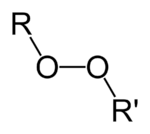Carbon–oxygen bond
A carbon–oxygen bond is a covalent bond between carbon and oxygen. [1] [2] [3] Oxygen has 6 valence electrons and prefers to either share two electrons in bonding with carbon, leaving the 4 nonbonding electrons in 2 lone pairs :O: or to share two pairs of electrons to form the carbonyl functional group. =O: Simple representatives of these two bond types are the _OH in alcohols such as the ethanol in beverages and fuels and the C=O in ketones (as well as many other related carbonyl compounds).[4]
Electronegativities and bond lengths
The C–O bond is strongly polarized towards oxygen (electronegativity of C vs O, 2.55 vs 3.44). Bond lengths for paraffinic C–O bonds are in the range of 143 picometer – less than those of C–N or C–C bonds. Shortened single bonds are found with carboxylic acids (136 pm) due to partial double bond character and elongated bonds are found in epoxides (147 pm).[5] The C–O bond strength is also larger than C–N or C–C. For example, bond strengths are 91 kilocalories (380 kJ)/mol (at 298 K) in methanol, 87 kilocalories (360 kJ)/mol in methylamine, and 88 kilocalories (370 kJ)/mol in ethane.[5]
Carbon and oxygen form terminal double bonds in functional groups collectively known as carbonyl compounds to which belong such compounds as ketones, esters, carboxylic acids and many more. Internal C=O bonds are found in positively charged oxonium ions. In furans, the oxygen atom contributes to pi-electron delocalization via its filled p-orbital and hence furans are aromatic. Bond lengths of C=O bonds are around 123 pm in carbonyl compounds. The C=O bond length in carbon dioxide is 116 pm. The C=O bonds in acyl halides have partial triple bond character and are subsequently very short: 117 pm. Compounds with formal C–O triple bonds do not exist except for carbon monoxide, which has a very short, strong bond (112.8 pm). Such triple bonds have a very high bond energy, even higher than N–N triple bonds.[6] Oxygen can also be trivalent, for example in triethyloxonium tetrafluoroborate.
Chemistry
Carbon–oxygen bond forming reactions are the Williamson ether synthesis, nucleophilic acyl substitutions and electrophilic addition to alkenes. The Paternò–Büchi reaction involves carbonyl compounds.
Oxygen functional groups
Carbon–oxygen bonds are present in these functional groups:
| Chemical class | Bond order | Formula | Structural Formula | Example |
|---|---|---|---|---|
| Alcohols | 1 | R3C–OH | -skeletal.png) |
Ethanol |
| Ethers | 1 | R3C–O–CR3 | .png) |
Diethyl ether |
| Peroxides | 1 | R3C–O–O–CR3 |  |
Di-tert-butyl peroxide |
| Esters | 1 | R3C–CO–O–CR3 |  |
Ethyl acrylate |
| Carbonate esters | 1 | R3C–O–CO–O–CR3 |  |
 Ethylene carbonate |
| Ketones | 2 | R3C–CO–CR3 |  |
Acetone |
| Aldehydes | 2 | R3C–CHO |  |
 Acrolein |
| Furans | 1.5 |  |
Furfural | |
| Pyrylium salts | 1.5 |  |
 Anthocyanins | |
See also
| CH | He | ||||||||||||||||
| CLi | CBe | CB | CC | CN | CO | CF | Ne | ||||||||||
| CNa | CMg | CAl | CSi | CP | CS | CCl | CAr | ||||||||||
| CK | CCa | CSc | CTi | CV | CCr | CMn | CFe | CCo | CNi | CCu | CZn | CGa | CGe | CAs | CSe | CBr | CKr |
| CRb | CSr | CY | CZr | CNb | CMo | CTc | CRu | CRh | CPd | CAg | CCd | CIn | CSn | CSb | CTe | CI | CXe |
| CCs | CBa | CHf | CTa | CW | CRe | COs | CIr | CPt | CAu | CHg | CTl | CPb | CBi | CPo | CAt | Rn | |
| Fr | CRa | Rf | Db | CSg | Bh | Hs | Mt | Ds | Rg | Cn | Nh | Fl | Mc | Lv | Ts | Og | |
| ↓ | |||||||||||||||||
| CLa | CCe | CPr | CNd | CPm | CSm | CEu | CGd | CTb | CDy | CHo | CEr | CTm | CYb | CLu | |||
| Ac | CTh | CPa | CU | CNp | CPu | CAm | CCm | CBk | CCf | CEs | Fm | Md | No | Lr | |||
| Core organic chemistry | Many uses in chemistry |
| Academic research, but no widespread use | Bond unknown |
References
- ↑ Organic Chemistry John McMurry 2nd Ed.
- ↑ March, J.; Smith, D. (2001). Advanced Organic Chemistry, 5th ed. New York: Wiley.
- ↑ Advanced Organic Chemistry Carey, Francis A., Sundberg, Richard J. 5th ed. 2007
- ↑ Clark, Jim (2000). "Bonding in Carbonyl Compounds". ChemGuide. Jim Clark. Retrieved 12 June 2014.
- 1 2 CRC Handbook of Chemistry and Physics 65Th Ed.
- ↑ Standard Bond Energies, Department of Chemistry, Michigan State University